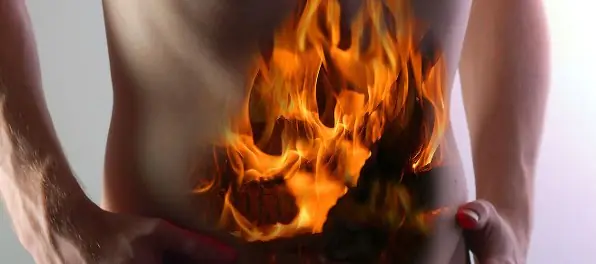
A burn to the esophagus and stomach occurs as a result of substances of elevated temperature or chemical reagents entering the internal organs of a person. Depending on the irritant, burns are classified as thermal or chemical.
- Thermal injuries develop from swallowing food that is too hot or from inhaling large amounts of steam.
- Chemical damage occurs as a result of damage to the walls of the stomach or esophagus by various chemicals and other harmful substances.
According to medical statistics, most burn injuries occur as a result of chemical exposure.
The most common chemical damages are:
- acid burn (vinegar essence);
- burn from alkali (caustic soda, caustic soda);
- burns with other substances (alcohol-containing liquids, phenol, gasoline, acetone, silicate glue, potassium permanganate solution).
At the first symptoms of a burn or after direct ingestion of irritating substances, the victim must be referred to a medical facility. A person’s life often depends on the timeliness of treatment measures taken, especially if the stomach or esophagus is damaged in children.
Signs of a burn
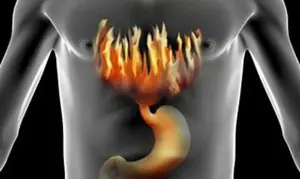
The soft tissues of the esophagus contain nerve endings, so after a burn the victim experiences severe pain. Pain in the abdominal area is the first sign of traumatic injury. In addition, pain can spread to the neck or back area. After a burn injury to the esophagus, traces of the burn (redness and swelling) are observed in the oral cavity and on the lips.
As a result of exposure to chemical reagents, the victim’s voice changes and hoarseness is observed.
The consequences of a traumatic injury are swelling of the esophageal mucosa, as a result of which the natural process of swallowing is disrupted in the victim. Tissue swelling is accompanied by shortness of breath, vomiting, and spasms of the esophagus.
When ingesting chemicals, not only the walls of the esophagus are affected, but also other components of the stomach. The chemical aggressor that gets inside destroys tissue cells, resulting in tissue necrosis.
In case of serious burn injuries, the formation of a hole in the esophagus, destruction of the bronchi and the occurrence of a fistula in the esophagus are observed.
Along with the main symptoms of a burn, the victim experiences chills, his body temperature rises, and his heart rhythm is abnormal.
The severity of a stomach burn depends on the duration of exposure of the aggressor to the internal organs, on the nature of its origin and on the concentration of the irritant substance. Accordingly, with more complex traumatic lesions, the victim experiences more painful symptoms, accompanied by general weakness and other negative symptoms.

Severity of burns
In medical practice, there are 3 degrees of severity of burns of the esophagus or stomach.
- First degree (mild stage). In case of a burn injury, only the upper layer of the soft epithelium is damaged, while the internal soft tissues are not affected. Symptoms of a 1st degree burn are redness and slight swelling of the mucosal walls, the victim feels slight pain. As a rule, no special medical intervention is required in this case, and all signs of a burn injury disappear within a half-month on their own.
- Second degree (middle stage). During a burn, the mucous membrane and internal muscle tissue of the esophagus or stomach are affected. As a result of the burn, severe swelling appears on the mucous membrane, and the surface of the mucous membrane itself becomes covered with ulcers. In this case, the victim must receive qualified medical treatment. If no complications arise as a result of the injury, the injury will heal within a month.
- Third degree (severe stage). As a result of a burn injury, all layers of the esophagus and stomach are damaged, and the damage often spreads to nearby internal organs. After the incident, the victim experiences shock and intoxication occurs in the body. Even if the victim receives timely medical care, scars remain at the burn site, and the wound heals in a period of 3 months to 3 years.
Treatment and first aid
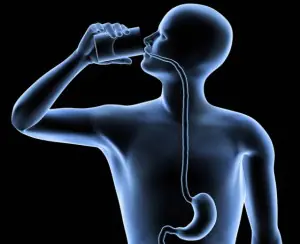
A 1st degree burn does not require drug treatment, but the victim still needs to be shown to a doctor to clarify the diagnosis and to carry out preventive procedures for complications after the burn. 2nd and 3rd degree burns require medical intervention, which is provided to the victim after providing primary care.
The further successful recovery of the patient from a burn of the esophagus and stomach depends on the speed and immediacy of primary care.
First aid:
- rinse the stomach. To do this, the victim must promptly drink at least 1 liter of clean warm water, and then induce vomiting;
- if the damage is caused by chemical compounds, then the reagent is neutralized. This action can only be carried out if the nature of the stimulus is reliably known. If the burn aggressor is not known, then neutralization is carried out only by doctors;
- the victim must be taken to a medical facility or an ambulance team must be called to the scene of the incident.
In a medical institution, the nature of the lesion is determined and the main aggressor of the burn is determined. After determining the necessary basics, the patient's stomach is washed again. If the victim experiences esophageal spasm, rinsing is carried out using a probe. Before using the umbrella, the esophagus is pre-treated with oil and the patient is given an anesthetic.
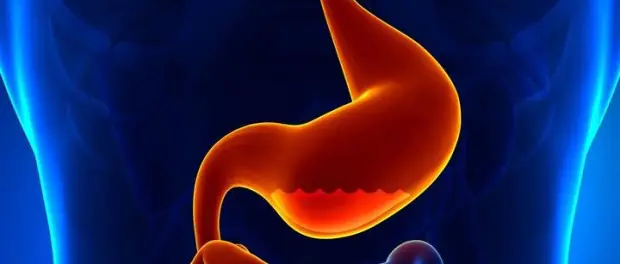
The main treatment for burns consists of the following procedures:
- taking painkillers;
- use of drugs to relieve esophageal spasm;
- normalization of the cardiac and excretory systems;
- preventing intoxication of the body;
- relieving the victim of shock.
As an additional treatment method, doctors recommend that the victim take vegetable oil orally. In addition, the victim should follow a strict diet.
Chemical burn of the esophagus and stomach
A dangerous chemical burn to the esophagus occurs as a result of intentional or accidental ingestion of aggressive chemicals. Most often, the aggressor of chemical damage is vinegar essence or alcohol-containing liquids.
- spasm of the esophageal muscles;
- sharp pain in the stomach area, radiating to the neck or back;
- pain shock;
- intoxication of the body;
- vomit;
- breathing problems;
- hoarseness of voice.
After a chemical burn, the victim must be urgently taken to a medical facility. Further successful treatment, and often the life of the victim, depends on the speed of provision of primary care.
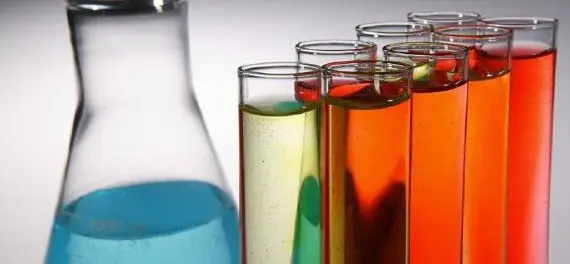
Acid burn
If it is reliably known that traumatic damage to the esophagus occurred due to acid, then the effect of the irritant must be neutralized with an alkaline solution. To prepare an alkaline solution, use baking soda (in the ratio of 1 teaspoon of soda per 1 liter of boiled warm water). The victim is given a prepared alkaline solution to drink and then vomited.
Alkali burn
As a result of a burn of the esophagus and stomach with alkali, gastric lavage is performed with acid solutions. In this case, you can use acetic, tartaric or citric acid. A small amount of the necessary acid is dissolved in a liter of warm and boiled water, and then the victim drinks the prepared solution. After which vomiting is induced.
Acetic or other acid can be replaced with vegetable or sea buckthorn oil.
Burn with alcohol (alcohol)

The degree of injury from a burn caused by an alcohol-containing substance is influenced by the amount of liquid drunk and its strength. The first signs of alcohol trauma are: dizziness, general weakness, loss of taste, pain in the stomach, abdomen, neck and back.
Primary care for burn injuries is gastric lavage. After this, the victim must be taken to a medical facility.
Vinegar burn
The most dangerous burn injury is caused by vinegar. The speed of initial assistance actions directly affects the future life of the victim. After taking vinegar, you must immediately rinse your stomach with an alkaline solution (soda solution) or plain water.
Even when the victim does not feel pain or changes in general physical condition, he still needs to be taken to a medical facility to provide basic treatment for a vinegar burn.
Thermal burn of the stomach or esophagus
Thermal damage to the stomach or esophagus occurs during the process of swallowing uncooled food or during intense inhalation of hot vapors.
In medical practice, thermal burns are not as common as chemical burns. 1st degree injuries can be treated with independent methods, but for burn injuries of 2nd and 3rd degrees, the victim must undergo treatment as prescribed by a doctor.
Food burn
When swallowing hot food or liquid, pain occurs in the esophagus. First aid for food burns involves cooling the walls of the esophagus. To do this, the victim needs to drink 1 liter of cool water in small sips.
With severe burns of the esophagus, damage to the walls of the stomach is possible.
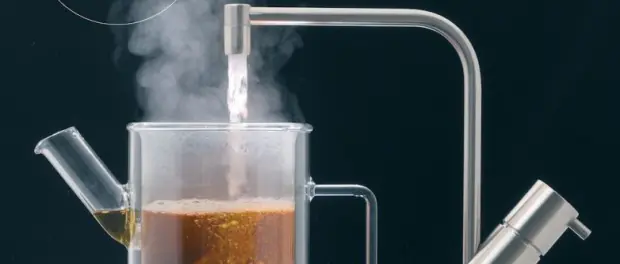
Boiling water burn
First aid for a burn with boiling water is similar to first aid for a burn with hot food. After a traumatic injury, the victim needs to drink enough cool water.
After a burn to the esophagus, the victim must follow a diet that excludes salty, spicy and smoked foods.
Burn of the esophagus and stomach in a child
In most cases, children suffer from burns of the esophagus and stomach. Kids drink the liquid they are interested in, but at the same time do not think at all about the possible consequences.
After a traumatic injury, adults urgently need to call an ambulance; this is important to do in a timely manner even in cases where there is a slight burn to the child’s esophagus.
First aid after a burn in a child is to lavage the stomach cavity; for this, the baby needs to drink a large amount of cool water and then induce vomiting.
Further treatment is prescribed only by the doctor after examining the little patient and conducting the necessary laboratory tests.
It is important for parents and adults to take care of the prevention of burn injuries to the child’s esophagus. To do this, you must follow these simple steps:
- Follow the rules for storing household chemicals. It should be kept out of the reach of children;
- Replace vinegar essence with vinegar. It must also be stored in places inaccessible to the baby;
- Conduct timely conversations with your child about the dangers of chemicals and the consequences of burns.
Alternative treatment for burns of the esophagus or stomach
After providing medical assistance as a result of 2nd and 3rd degree damage, as well as after a 1st degree burn, the victim can use traditional therapy. Traditional therapy methods will help normalize the physical condition of the victim and promote rapid wound healing and restoration of the functions of the esophagus and stomach.
- take 1 tbsp daily on an empty stomach. a spoonful of vegetable, sea buckthorn or olive oil;
- drink fresh milk several times a day;
- three times a day, take 1 glass of decoction of medicinal herbs (chamomile grass, quince seeds, marshmallow roots).
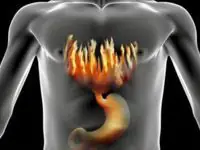
A burn of the esophagus is damage to its walls due to the ingress of chemicals. Less commonly, the causes of the phenomenon are the consumption of foods or drinks with high temperatures, or radiation exposure. In more than 60% of cases, burns occur in children, so it is important for everyone to know the symptoms and first aid rules in order to respond in time to damage to the esophagus in themselves or others.
Types of esophageal burns
Depending on the factors that provoke damage to the walls of the esophagus, several types of burns are distinguished; they are shown in the table below.
| Chemical | It is provoked by the use of certain chemicals. This happens either deliberately, as an attempt at suicide, or by accident. Often adults and children burn themselves with vinegar, an affordable product available in every kitchen. |
| Thermal | Caused by consuming excessively hot food and drinks. The consequences affect both the stomach and esophagus: the mucous membranes of both organs are affected. This condition is especially dangerous for patients with ulcers and other chronic diseases of the digestive system. |
| Ray | It is rare, the main cause is a complication after radiation therapy performed to treat malignant tumors. |
Some experts classify alcohol burns as a separate group, which occurs due to drinking large quantities of alcohol or low-quality drinks. This problem occurs not only among people with an immoral lifestyle; to get a burn, it may be enough to drink a cheap, low-quality alcoholic drink once.
What causes a chemical burn
Chemical burns of the esophagus are the most common type. The severity of the damage and how serious the consequences will be depends on the composition of the liquid.
Corrosive substances that have an aggressive effect and can cause a burn to the esophagus are:
- Oxidizing agents. Often they are hydrogen peroxide, iodine, ammonia. The inflammatory process persists for up to 2–3 weeks, the symptoms are mild. In most cases of oxidant burns, home treatment is sufficient.
- Acids. More serious damage to the mucosa is observed. Stenosis appears - a phenomenon in which the lumen of the esophagus narrows. As a result, its patency is disrupted, which leads to difficult functioning of the entire digestive system. When an acid burn occurs, coagulation necrosis often occurs, and the tissues of the esophagus and stomach are damaged.
- Alkalis. The most dangerous provocateur of a chemical burn of the esophagus, requiring urgent hospitalization. The tissues of the esophagus and stomach suffer, and under the influence of chemicals they lose strength. As a result, alkali penetrates into other internal organs, having a destructive effect.
Degrees
There are three degrees of esophageal burn:
- Easy. The inflammatory process affects the upper layer of the epithelium. Redness, swelling, and irritation appear on the mucous membrane. Within a few weeks, the damage disappears; if drug treatment is prescribed, it consists of gentle agents.
- Average. In addition to the epithelium, the damage extends to the mucous membrane of the esophagus and the muscle layer underneath it. Due to severe swelling, stenosis appears, sometimes the lumen is not visible at all. Ulcerations appear on the surface of the esophagus.
- Heavy. The lesion affects all layers of the esophagus and, in the absence of proper treatment, spreads to nearby organs.
When the inflammatory process is at stages 1–2, following the doctor’s recommendations, it is possible to get rid of its symptoms within 2–4 weeks. With a severe chemical burn, the consequences can be chronic.
Symptoms
Symptoms of a burn to the esophagus depend on what caused the damage to the organ and how severe the inflammatory process is. Much also depends on the age of the victim (children endure chemical burns especially difficult), the presence of chronic diseases, and the individual characteristics of the body.
The main symptoms observed in most cases are:
- severe pain in the larynx, chest, stomach;
- damage to the oral cavity: redness, swelling, often affecting the lips;
- shortness of breath, suffocation;
- lack of voice, hoarseness;
- increased heart rate, lightheadedness;
- weakness, nausea, vomiting (often vomit contains blood and mucus).
It is especially difficult to diagnose a burn in children who have swallowed a chemical liquid without the knowledge of their parents. It is important to question your child to determine what the problem is as quickly as possible. In any case, if you suspect a burn to the esophagus, you must immediately call an ambulance.
First aid
Before specialists arrive, it is necessary to provide the victim with all possible first aid. The principles of its implementation are effective for both chemical and thermal burns. The first thing to do is rinse the stomach. It is necessary to give the victim water to drink, preferably with potassium permanganate (add a few crystals to 1 liter of water). The sooner a person vomits out the remaining toxins, the less harm they will have time to cause.
After gastric lavage, it is necessary to neutralize the effect of the substance taken. The basic rule is related to the properties of acids and alkalis: one neutralizes the other. If the victim has damaged the esophagus with vinegar essence or any other acid, it is necessary to take a soda solution. To do this, dissolve half a teaspoon of baking soda in a glass of water at room temperature.
If alkali enters the body and causes a burn, you must take acid. The easiest way is to squeeze the juice of half a lemon into a glass of water at room temperature. You can alleviate the pain by taking a little warm milk.
Treatment
Treatment for a burn of the esophagus is carried out on an individual basis, prescribed by a doctor after examining the victim and conducting diagnostics. Typically, comprehensive therapy is required, consisting of the following measures:
- gastric lavage using a tube (the procedure is painful, so painkillers are often administered before it);
- spasm relief;
- prescription of antibiotics;
- infusion of saline solutions and other means to maintain the normal functioning of the liver and other internal organs;
- general strengthening procedures.
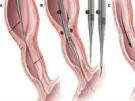
The table below shows commonly used drugs:
| Painkillers | Analgin, Morphine |
| Antispasmodics | Atropine |
| Sedatives | Relanium |
| Antishock | Sodium bicarbonate, Reopoliglucin |
| Antibiotics | Ampiox and others, broad spectrum |
In case of severe damage to the esophagus, the victim is taken to a medical institution, whose specialists can perform an operation. Surgery is required to remove the affected areas of the esophageal mucosa by excision.
Treatment of thermal burns of the esophagus
If a thermal injury occurs due to one-time consumption of a large amount of hot food or boiling water, the same measures must be applied as in the case of a chemical injury. In most cases, gastric acid damage due to poor diet or alcohol abuse occurs over a long period of time and gets worse.
For therapy to be successful, complete abstinence from alcohol and dietary adjustments are required. Medication is mandatory because if left untreated, complications may arise. Due to a thermal burn, esophageal stenosis also appears and the functioning of the digestive system is disrupted.
Doctors advise treating damage to the esophagus with drugs of three groups, taking them simultaneously:
- alginates that create a protective film around the mucous membrane: Almagel, its analogues;
- drugs that accelerate metabolism: Motilium, Motinol;
- drugs that normalize acid levels: Lanza, Nolpaza.
If damage to the esophagus by alcohol or hot food is serious, immediate hospitalization is required. As with chemical burns, particularly severe cases may require surgery.
Elimination of burn strictures
Burn strictures of the esophagus – scarring. They usually occur with severe chemical burns. To eliminate them, an operation is prescribed, which is recommended to be performed at least 1 month after the injury.
Depending on the degree of the inflammatory process, there are two types of burn strictures:
- complete – there is no lumen in the esophagus;
- incomplete - a small gap remains.
The stricture can be of any length, sometimes it affects neighboring internal organs, especially the stomach. Doctors make diagnoses using radiography.
After this, a decision is made to choose one of the possible treatment methods for burn strictures:
- Bougienage. It appears to be effective in the treatment of short burn structures.
- Surgical intervention. It is prescribed if bougienage does not bring results or the burn strictures are too long.
The doctor prescribes one of the treatment options, explaining to the patient the essence of the procedure.
Diet after a burn
A burned esophagus requires special care for a long time after the inflammatory process has resolved. For this purpose, a diet is prescribed, which, in case of second and third degree injuries, will have to be followed for life. Its principles are:
- the temperature of the food consumed should be the same as body temperature; cold and hot foods are strictly prohibited;
- At first, dishes should only be liquid; it is advisable to blend everything through a blender;
- over time, the consumption of semi-liquid food is allowed;
- You can’t eat dry food;
- All dishes can be boiled, stewed, steamed; other heat treatment options are contraindicated.
If you have a first-degree burn, you can switch to a normal diet no sooner than after a few weeks. For the second and third diet adjustments, the attending physician is appointed. Usually the victim fasts for the first few days. Therefore, there is no identical diet for all cases; it is prescribed depending on the degree of damage to the esophagus, neighboring organs, the timeliness and effectiveness of treatment.
Thus, a burn of the esophagus is a dangerous injury to an internal organ. The most common and dangerous type is a chemical burn. It often occurs in children who swallowed chemicals out of curiosity. Thermal burn usually develops gradually against the background of alcohol abuse and bad eating habits. Treatment of any type of injury depends on its severity and individual factors.
An esophageal burn is a traumatic injury to the upper digestive tract, which is the most common reason for visiting a gastroenterologist. The clinical condition can have different degrees, forms and types of damage. Thus, in medicine, a distinction is made between thermal, radiation and chemical burns of the esophageal canal in adults and children. The features of injuries to the digestive system and the treatment of burns of the upper digestive system will be discussed in this article.
Causes
Thermal burn of the esophagus mainly occurs in humans accidentally, after eating hot food and/or burning the mucous membrane with boiling water. However, accidental or intentional consumption of corrosive liquid during a suicide attempt is also not uncommon.
Chemical burns of the esophagus in children and/or adults are determined after internal consumption:
- concentrated acid components - vinegar essence, hydrochloric acid or battery electrolyte;
- alkaline hydroxides - caustic soda (caustic sodium), ammonia;
- other chemically aggressive components - potassium permanganate (potassium permanganate), hydrogen peroxide, silicate glue, ethyl alcohol, acetone and so on.
In addition to mucous damage to the esophagus, burn injuries also occur in the pharyngeal tract and stomach.
According to statistics, up to 70% of victims of chemical burns of the esophagus are children aged from one to six years.
This fact is explained by the natural curiosity of the child and the carelessness of the parents. Among adults, a chemical burn is usually detected when a person deliberately attempts to commit suicide. Clinicians testify that among this category of patients, the majority are women. Radiation burn of the esophagus is a fairly rare type of injury to the upper digestive tract. The causes of the damage are explained by the effect of ionizing radiation on the mucous surface as a result of radiation or x-ray exposure.
Types of burn injury
Regardless causes of pain in the esophagus, damage to the mucous surface during a burn of the esophagus is determined by three degrees of severity of the clinical condition:
- A 1st degree burn of the esophagus affects only the upper layer of the epithelium and is characterized by swelling and redness of the mucous membrane of the digestive system.
- A 2nd degree burn of the esophagus involves penetration and partial destruction of the submucosal layer down to contact with muscle cells. Characteristic signs of thermal or chemical damage to the mucous surface of the 2nd degree are ulcerated areas, forming the so-called fibrinous esophagitis.
How to promptly determine and correctly provide first aid in case of a burn to the esophagus after hot food or in case of damage to the digestive organ by chemicals?
Signs of thermal and/or chemical damage
Burns of the esophagus in children and adults are accompanied by severe pain felt in the upper abdomen, behind the sternum and in the neck. Also, traces of burn injuries are determined by swelling on the lips and oral cavity. In addition, the person experiences shortness of breath, hoarseness in the voice, or the ability to pronounce sane sounds completely disappears. The impact of an aggressive environment on the mucous surface destroys the cellular structure and leads to tissue necrosis, which entails a physiological narrowing of the esophagus, and as a result, the person begins to suffocate.
With a chemical aggressive lesion, the wall of the esophagus can collapse with the formation of a hole, and in especially severe cases, an esophageal-tracheal fistula is observed, accompanied by suffocation, uncontrollable coughing and the release of sputum with food fragments. As a rule, patients after a burn of the esophagus with chemically active compounds are admitted to a medical facility in a state of shock or unconsciousness. Treatment often requires resuscitation measures.
Treatment of esophageal burn
Despite intensive therapy, mortality from chemical burns of the esophagus is quite high, amounting to about 10%. Basically, this indicator is determined in a group of patients who have committed suicidal actions, the cause of which is depression, traumatic situations, paranoid disorders, alcoholism or concomitant pathologies - cancer, diabetes, bronchial asthma and other diseases. The fatal outcome is due to the amount of the reagent taken and the person’s untimely seeking of medical help. Morphological changes in the esophagus and the body as a whole require emergency diagnosis and special treatment tactics.
After the patient is admitted to a hospital hospital, gastric intubation is prescribed in order to inactivate the damaging chemical and extract its residual contents. Treatment for a burn of the esophagus with alkali involves washing the stomach with a non-concentrated solution of acetic acid, and neutralizing the acids with a soda solution.
Attention! It is advisable to perform gastric lavage in the first 4-6 hours, after which this procedure becomes meaningless.
After eliminating the reagent, the patient is given a medicinal antibiotic to prevent purulent complications. A severe form of chemical burn of the esophagus requires forced diuresis with an osmotic diuretic, for example, Mannitol®. Sometimes renal failure and hemolysis become a complicating factor, requiring extrarenal blood purification - hemodialysis.
After therapeutic measures have been carried out and the patient’s well-being has improved, on days 7-10, bougienage of the esophagus is performed, which allows to expand the lumen of the digestive organ and reduce the development of rough cicatricial strictures in the esophageal canal. In case of complete or partial obstruction of the esophageal canal, surgical treatment is provided - endoscopic dilation, stenting or plasty of the esophagus.
First aid
At home, it is impossible to determine the degree of damage to the esophageal canal. After the first symptomatic signs of a burn to the esophagus appear, it is necessary to urgently call an ambulance. Pre-medical measures consist of removing caustic chemical components from the stomach through minor gastric lavage. The patient needs to drink 2-3 glasses of water to induce vomiting. No other first aid measures should be carried out. The further choice of therapeutic treatment regimen will be determined by the emergency physician.
Folk remedies for treating esophageal burns
After therapeutic elimination of pain in the esophagus due to a chemical burn, the mucous membrane can be restored using folk remedies at home approved by the attending physician.
Recipe No. 1. As first aid for mild damage to the esophageal tube, traditional medicine recommends milk, egg whites and vegetable oil. It is necessary to prepare a healing mixture of 200 ml of milk, a teaspoon of vegetable oil and three egg whites. Such a home remedy can neutralize the effects of an aggressive chemical environment.
Recipe No. 2. A decoction of flax seeds has an enveloping and healing effect on the mucous wall of the esophageal tube. Ten teaspoons of flaxseeds are poured into 250 ml of water and boiled for 10 minutes over low heat. After filtering and cooling, the healing liquid is taken in small sips.
Recipe No. 3. A decoction of medicinal chamomile will help prevent complications and prevent an inflammatory reaction. Two teaspoons of dry raw materials are brewed in a glass of water like regular tea. The medicine is infused for 10-15 minutes, taken 2 times a day.
Possible complications
As a result of an intentional or careless burn of the esophageal canal, the following clinical conditions may develop that require additional therapeutic or surgical treatment:
- Cicatricial narrowing or stenosis of the esophagus, when the diameter of the esophageal canal decreases. Clinical manifestations are bleeding, dysphagia.
- Achalasia cardia, characterized by insufficient relaxation of the lower esophageal sphincter. Clinical manifestations are difficulties in swallowing, return of food mass from the stomach to the oral cavity.
Prevention of esophageal burns
The most important preventive measure will be conversations with children on the topic of safety. It is necessary to promptly explain to the child about the dangerous effects of chemical compounds on the digestive tract, and that detergents and other household chemicals should be used only for their intended purpose.
Adults must follow the rules for storing dangerous and harmful household chemicals. Such products must be labeled and kept separate from food and water and out of the reach of children. To avoid thermal burns of the esophagus, it is recommended to eat food with a temperature of no higher than 40 degrees Celsius. Frequent consumption of hot food can lead to spasms of the esophagus or cause other inflammatory reactions. People with suicidal tendencies are recommended to seek help from a psychologist or a specialized specialist for the type of illness. Take care of yourself and always be healthy!



